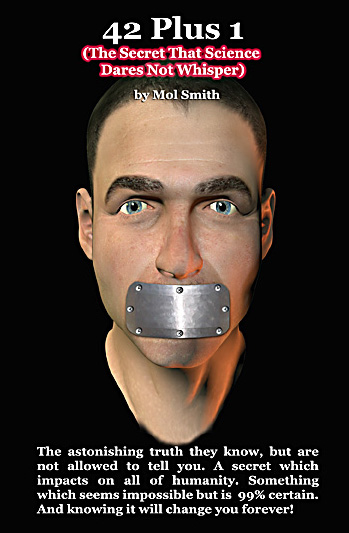42 PLUS 1
The official web site of the book
by Mol Smith
Preview 2
|
Extract from Chapter 12 The Allegory of the Cave (also titled Analogy of the Cave, Plato's Cave or Parable of the Cave) is presented by the Plato in his work The Republic. It is written as a dialogue between Plato's brother Glaucon and his mentor Socrates, narrated by the latter. Plato has Socrates describe a gathering of people who have lived chained to the wall of a cave all of their lives, facing a blank wall. The people watch shadows projected on the wall by things passing in front of a fire behind them, and begin to designate names to these shadows. The shadows are as close as the prisoners get to viewing reality. He then explains how the philosopher is like a prisoner who is freed from the cave and comes to understand that the shadows on the wall do not make up reality at all, as he can perceive the true form of reality rather than the mere shadows seen by the prisoners. He imagined our perceptions to be but a faint inkling of a far richer reality that flickers beyond our reach. Two millennia later, Plato’s cave may be more than a metaphor. To turn his suggestion on its head, reality—not its mere shadow—may take place on a distant boundary surface, while everything we witness in the three common spatial dimensions is a projection of that faraway unfolding event. Reality, itself, may be a hologram. Or at least—the universe we think we live in is the hologram! If we exist in this shadowy reality, our very lives, our thoughts, our movements, may themselves be no more than projections from the real us, and from where we really exist, in a far more detailed and may I say it—more real invocation of ourselves. This is not some pseudo-scientific wish or excuse to support the bias throughout my book towards suggesting the real us are beyond our physical minds here and not within them. If you wish, you can look at your shadow on the wall, and imagine that 2 dimensional form thinking itself real. The shadow bumps into things even when you don’t. If the light projecting your shadow there goes out, the shadow dies, but you don’t. Maybe life here is just like that? There is a very strong scientific theory suggesting that you, this universe, and everything in it is in fact not real! We, along with our universe, might just be holograms—projections from a real existence at the boundary of our 3D space. The problem now is how best to explain to you where this idea came from and why it should be taken as a serious theory, one which even as I write... (Continues...) |
|
|
|
About the author: Mol smith is the founder and coordinator of one of the most visited science sites on the Internet: Microscopy-UK and is the author of
several published books relating to science. |
